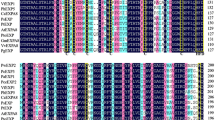Abstract.
To investigate the evolutionary history of expansins and their role in cell elongation in early land plants, we isolated two α-expansin genes, Mq-EXP1 and Rd-EXP1, respectively, from the semiaquatic ferns Marsilea quadrifolia L. and Regnellidium diphyllum Lindm. The deduced amino acid sequences of the fern expansins exhibit a high degree of identity to those of seed plants, showing that expansin genes were conserved during the evolution of vascular plants. Gel-blot analysis of M. quadrifolia and R. diphyllum genomic DNA indicated that, in both ferns, α-expansins are encoded by multigene families. Expression of α-expansin genes probed with Mq-EXP1 was confined to the elongating region of the Marsilea rachis. Cell-wall proteins of M.␣quadrifolia induced in-vitro extension of acidified cucumber cell walls. In R. diphyllum, expression of Rd-EXP1 increased when elongation of the rachis was enhanced by submergence or ethylene. These results indicate that α-expansins act as wall-loosening proteins in ferns, as has been proposed for angiosperms. In addition, Rd-EXP1 may play a role in mediating elongation of the rachis in submerged plants.
Similar content being viewed by others
Author information
Authors and Affiliations
Additional information
Received: 7 March 2000 / Accepted: 29 April 2000
Rights and permissions
About this article
Cite this article
Kim, J., Cho, HT. & Kende, H. α-Expansins in the semiaquatic ferns Marsilea quadrifolia and Regnellidium diphyllum: evolutionary aspects and physiological role in rachis elongation. Planta 212, 85–92 (2000). https://doi.org/10.1007/s004250000367
Issue Date:
DOI: https://doi.org/10.1007/s004250000367




